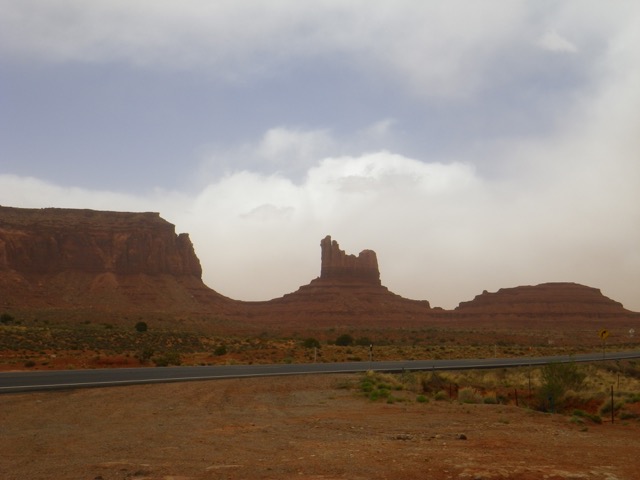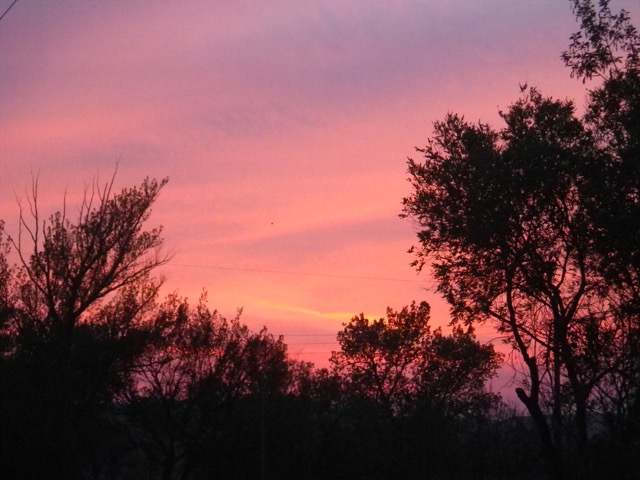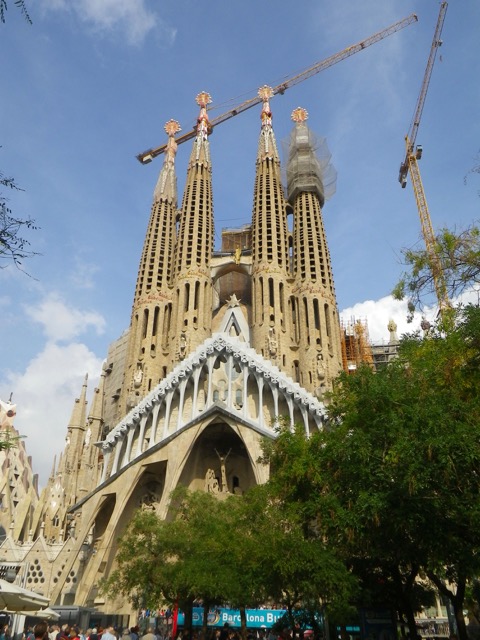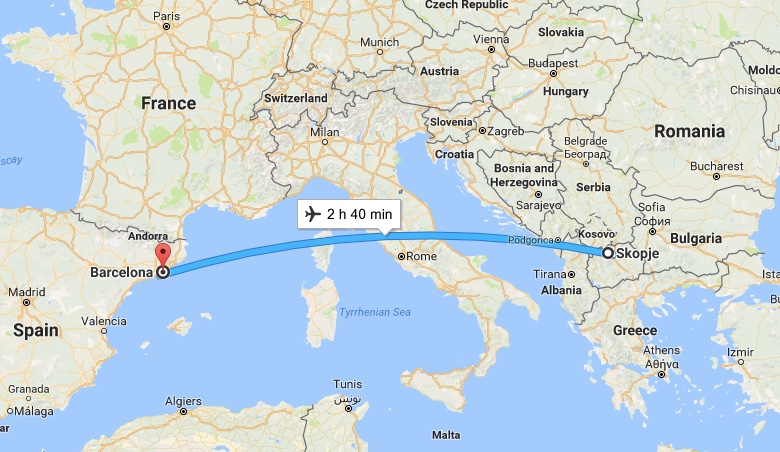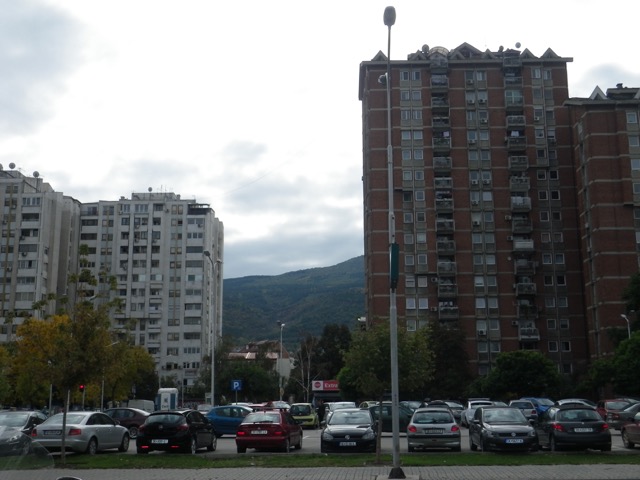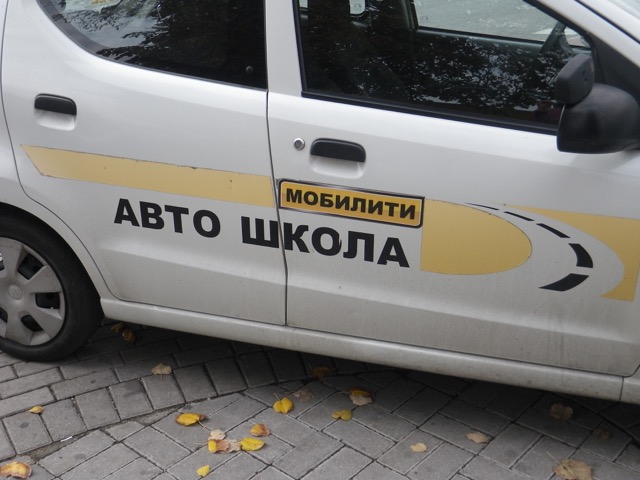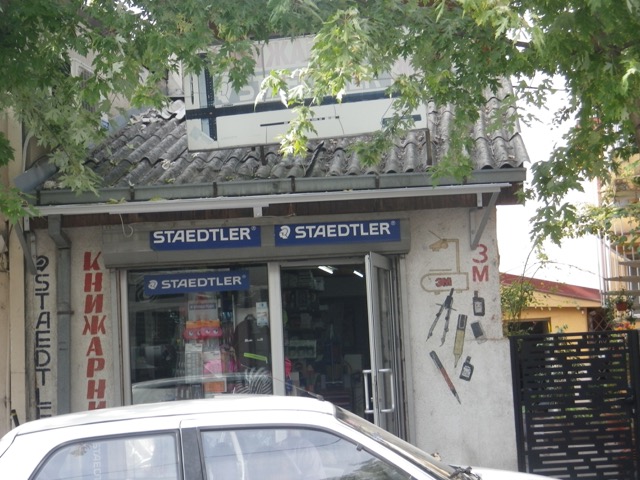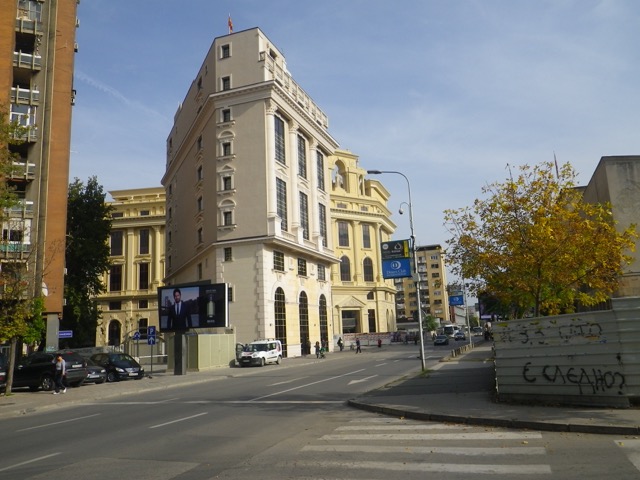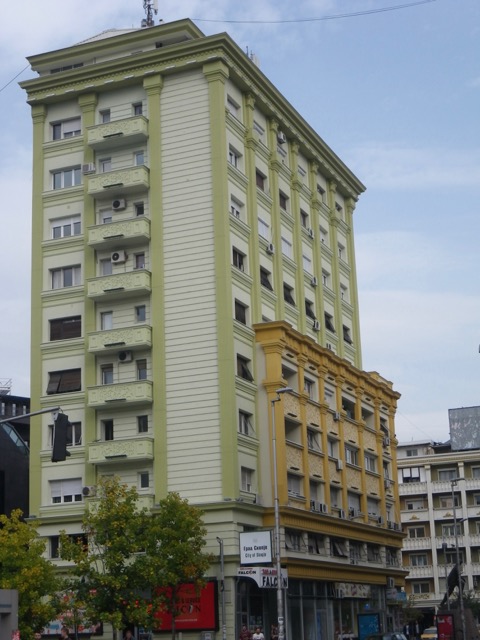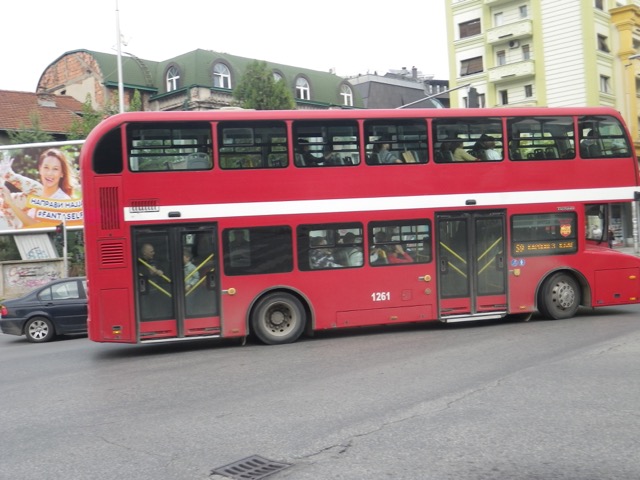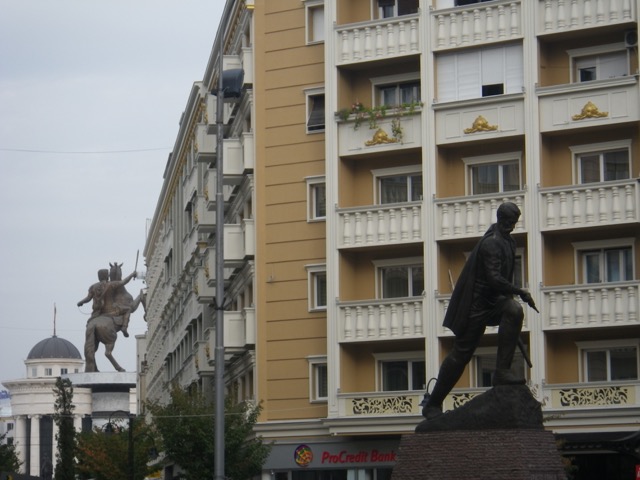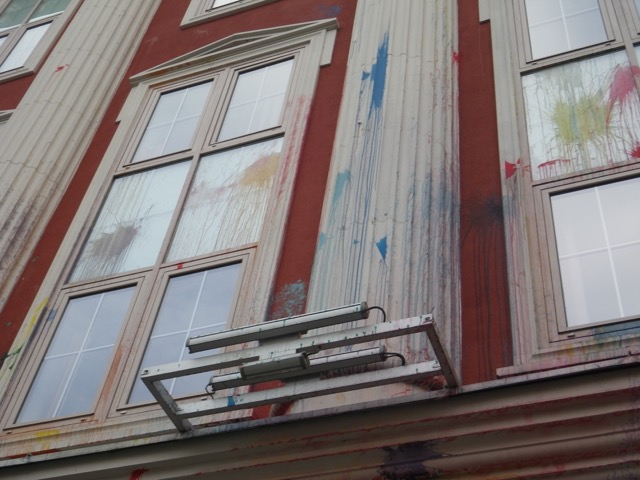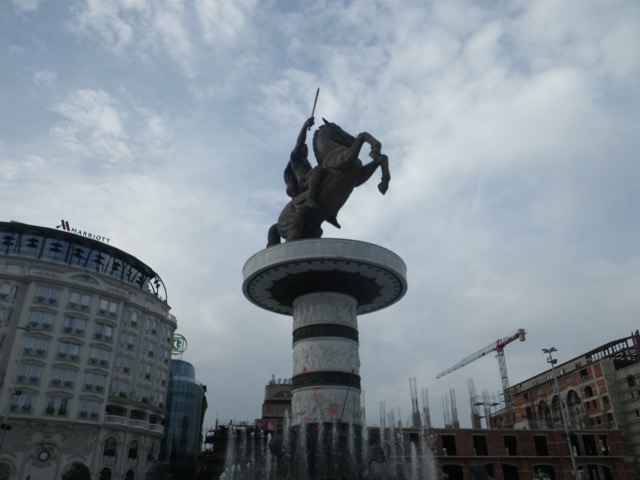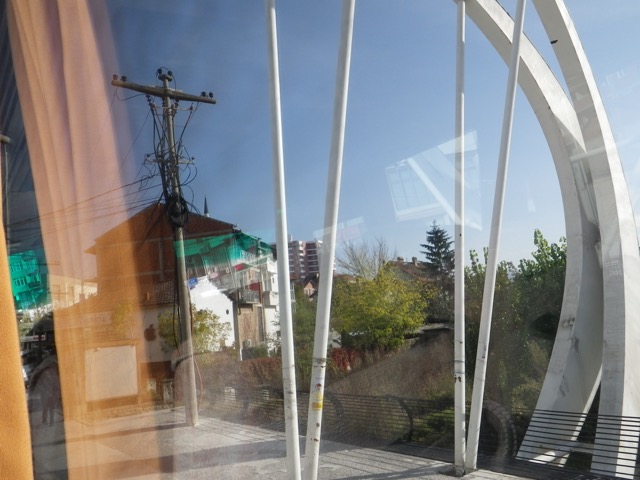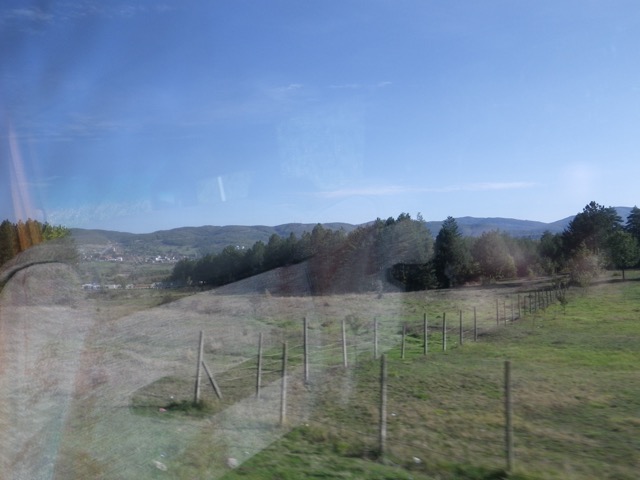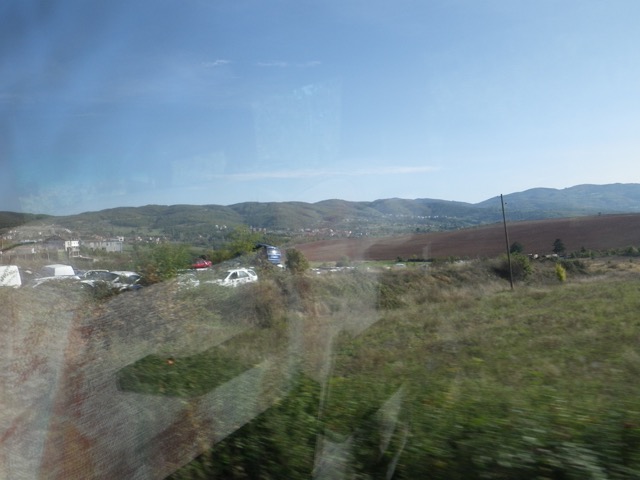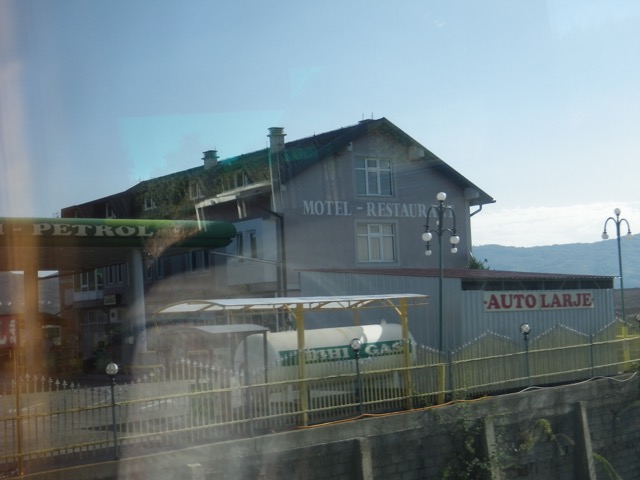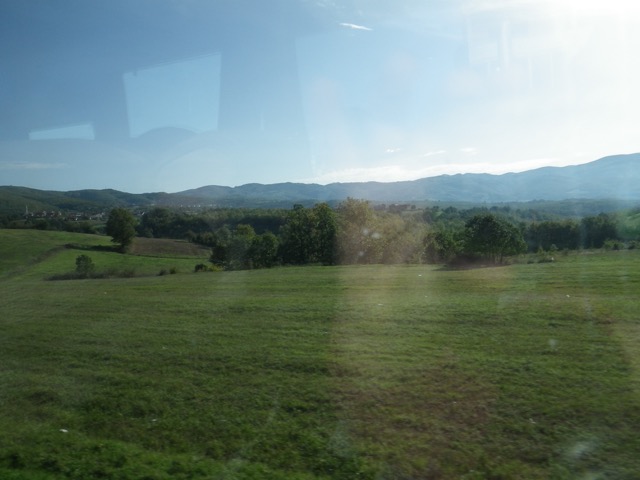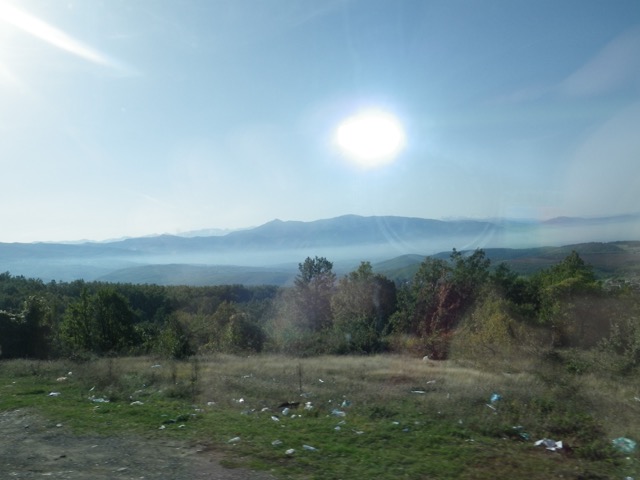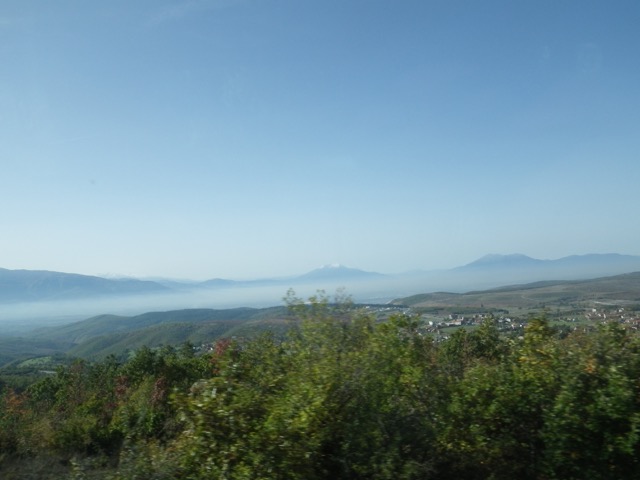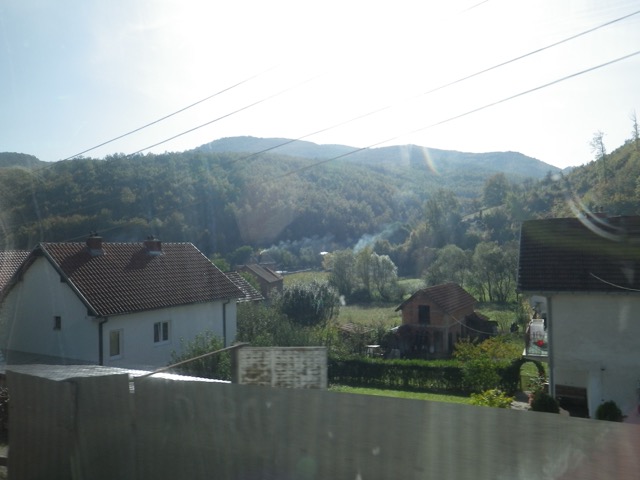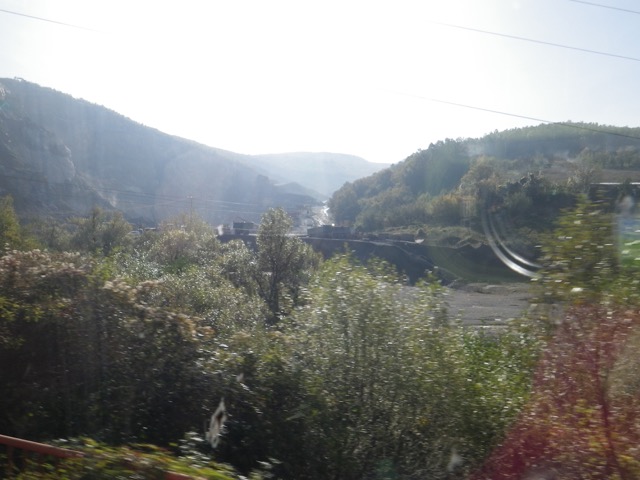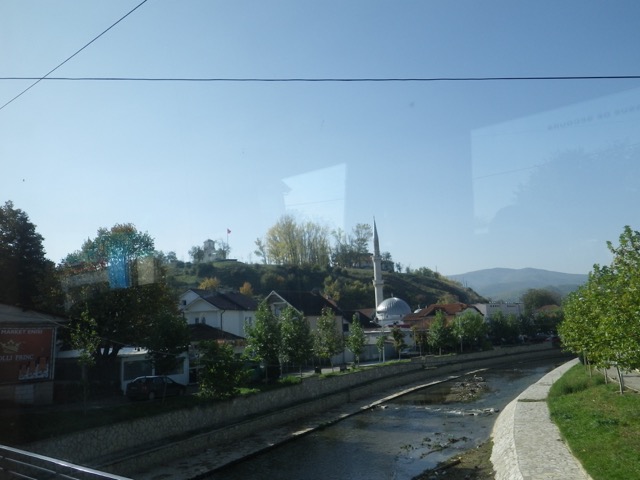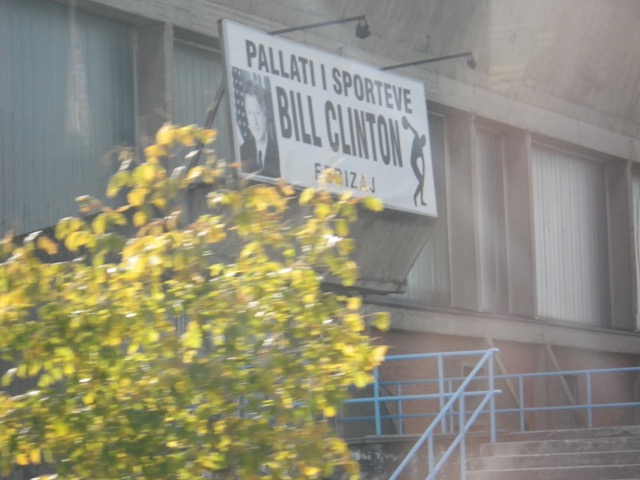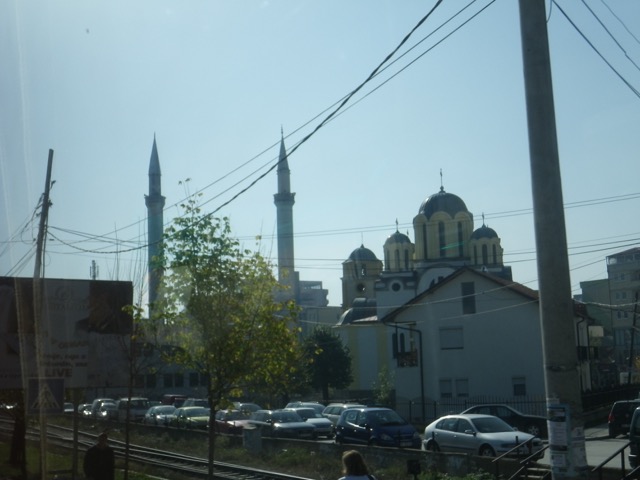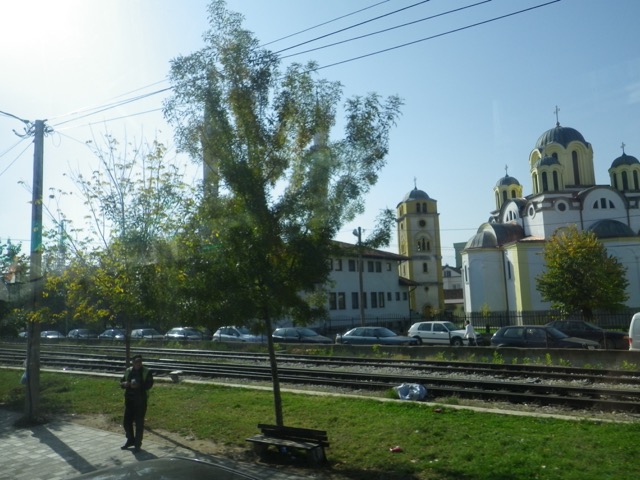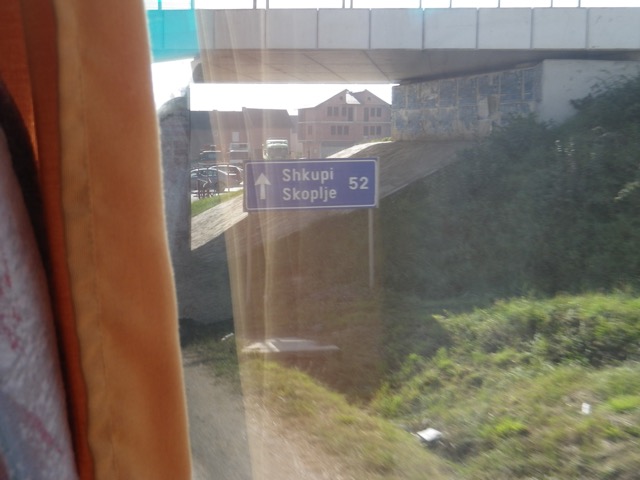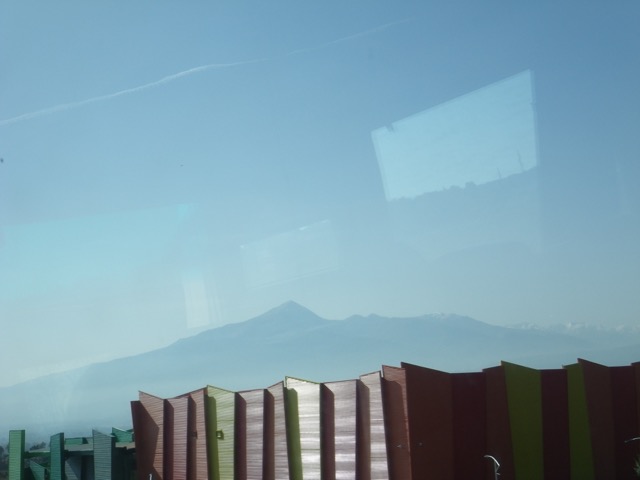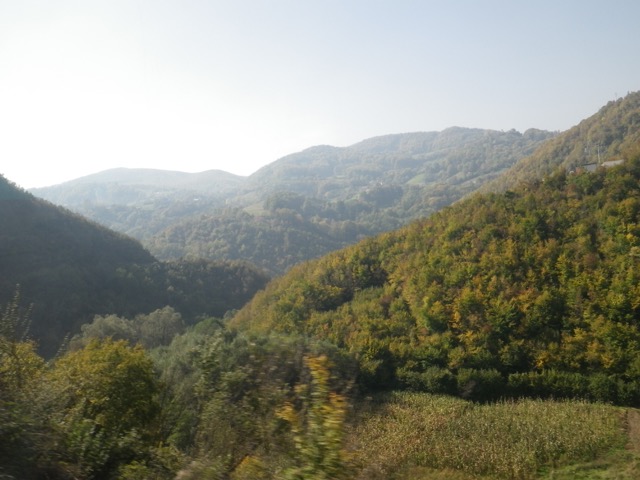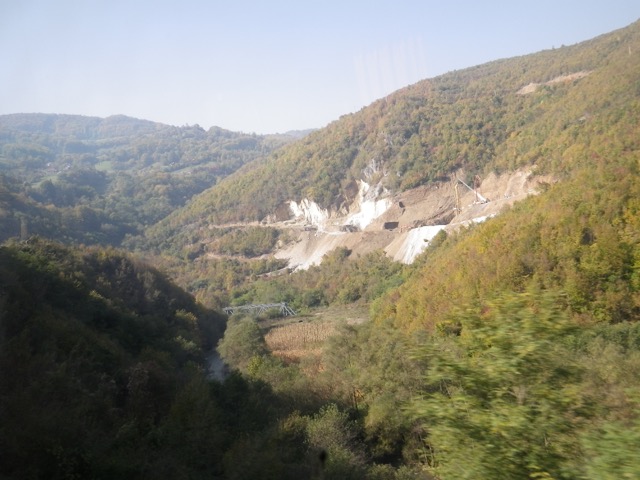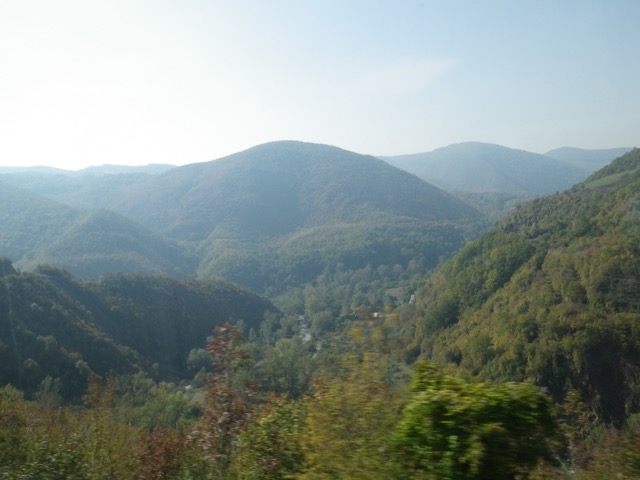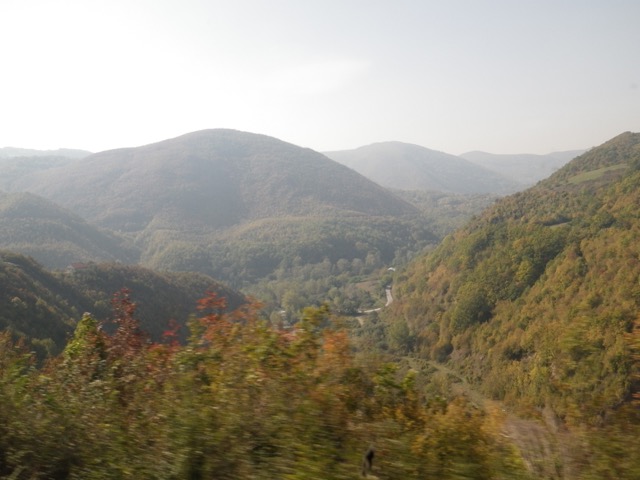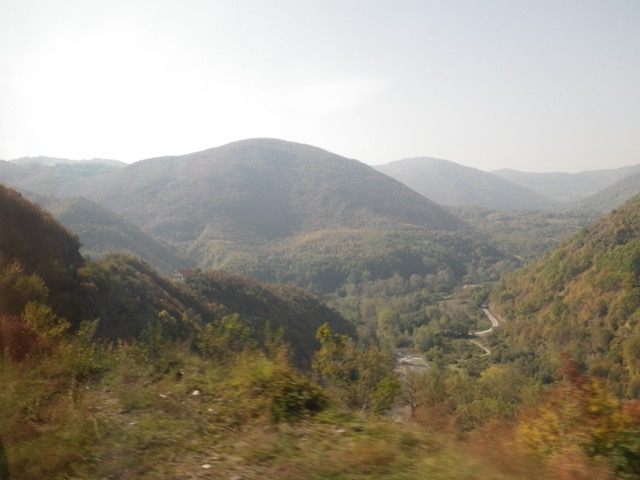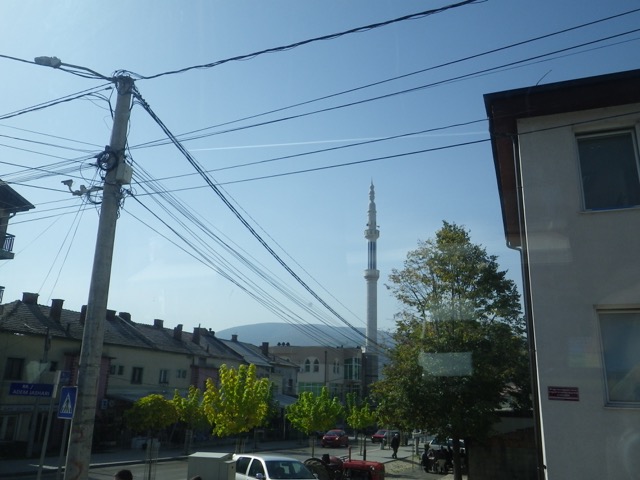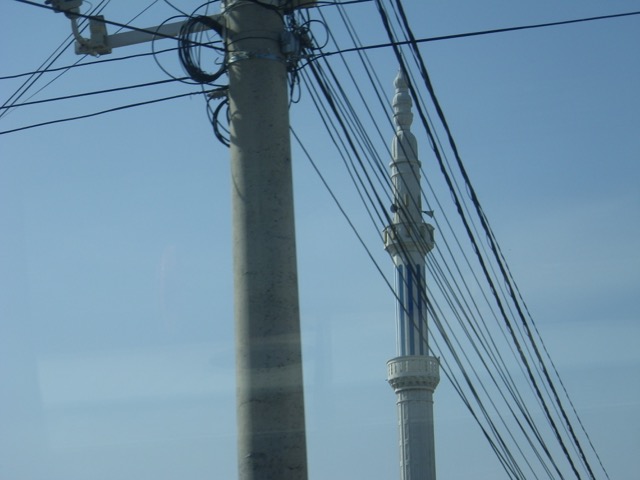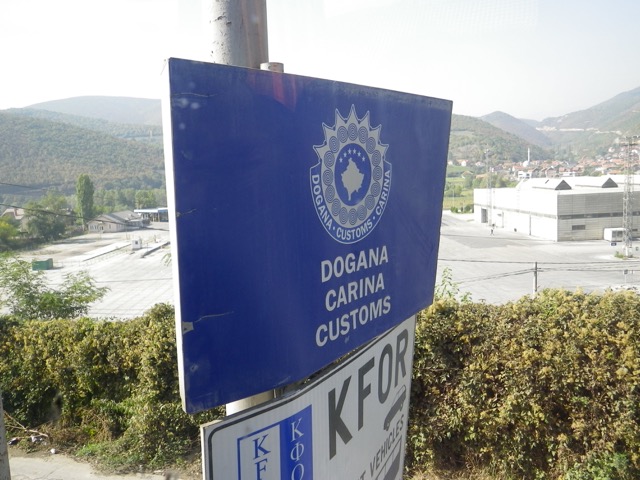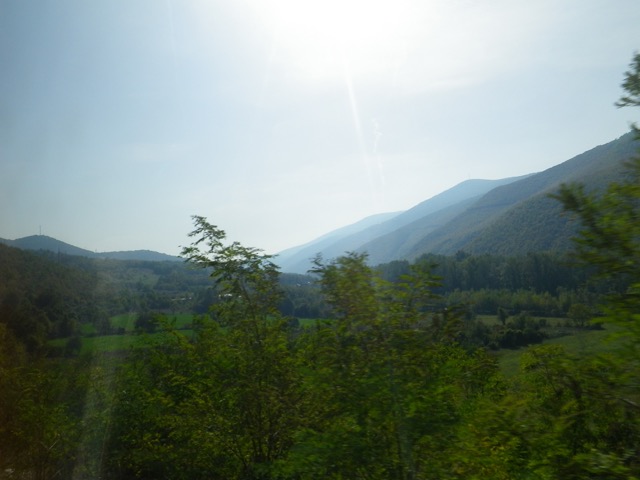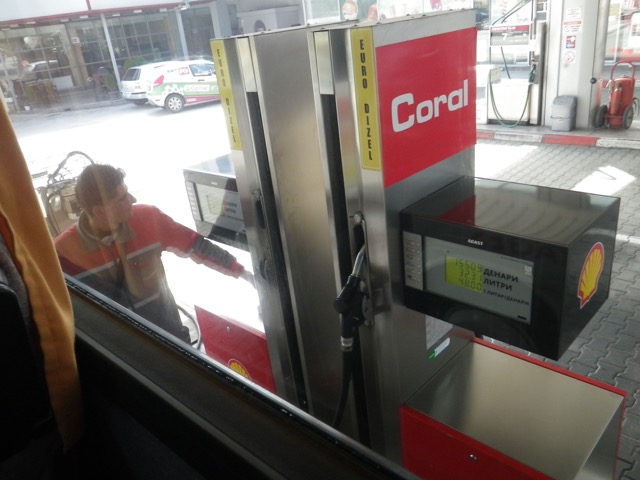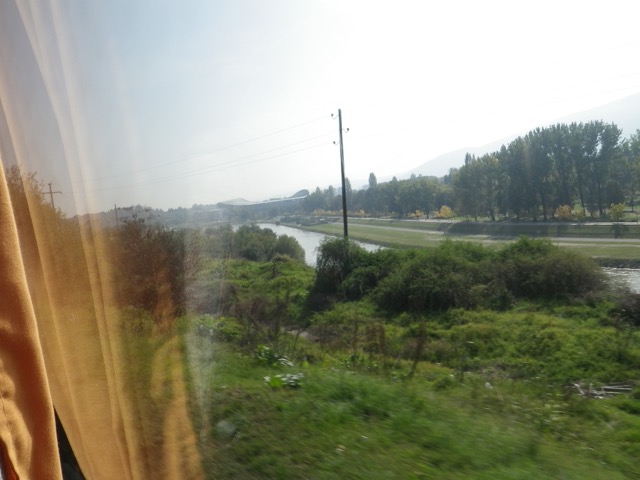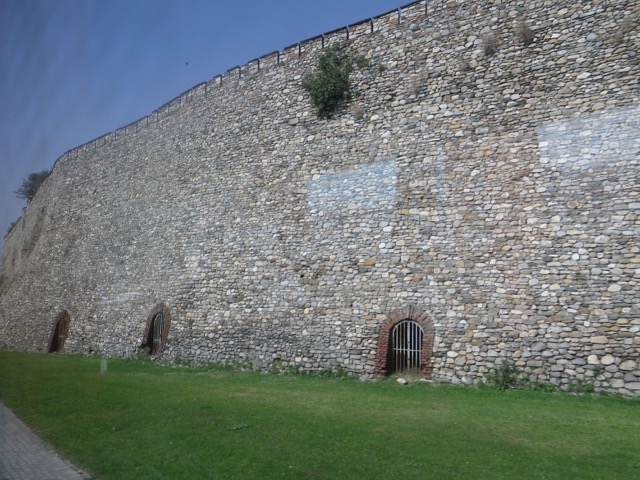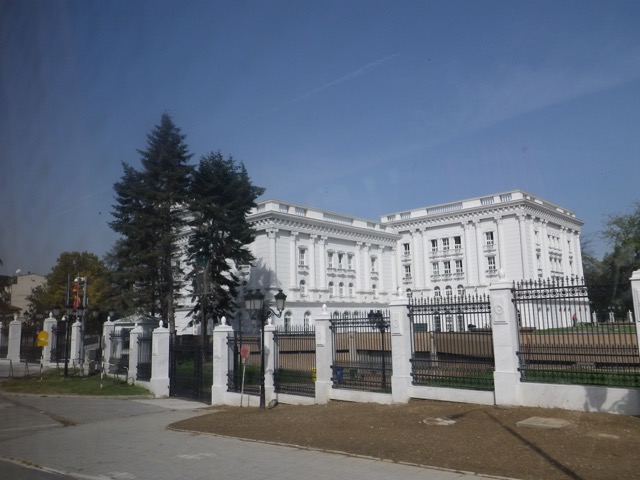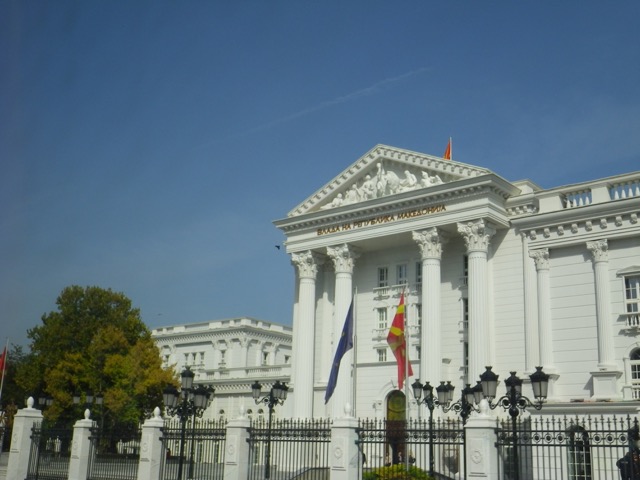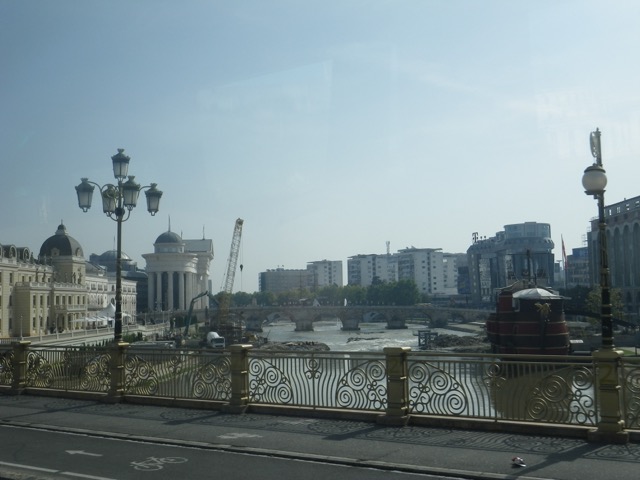I awoke to a downpour. The forecast promised a clearing during the time of my walking tour, but I wasn’t holding my breath and was glad it wasn’t cold. I got up fairly early so I could get a bit of work done before the tour, but actually lost track of time and before I knew it, it was 9:30, with the tour being at 10:00 and a 20-minute walk away!
I managed to get out the door in about five minutes since I was dressed. It’s a good thing I’d scoped out the starting point of the tour yesterday, Memorial House of Mother Teresa, and knew a fairly direct way to get there. I also knew that these tours never start on time so I would be fine. Sure enough, I arrived around 9:48 and found a dry spot to wait for the tour to start.
Mother Teresa is thought of as being Albanian, but she was born in Skopje and lived here till she was 18 before going to Ireland to learn English. More on her later in the tour as this was not our first stop.


This church is brand new.

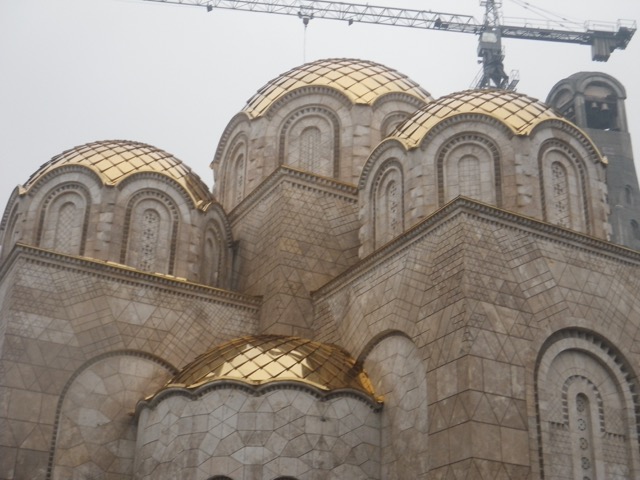

Our guide, Miho of Skopje Walks, was a little early and asked a gal from London and me if we’d mind waiting a bit to see if anyone else turned up. A gal from Poland working in Skopje did and then just as we were ready to set off, two Portuguese gals came running.
Our first bit of information was about the pedestrian street we were standing on, Macedonia Street. It is a fairly new street, about 100 years old, and was built to carry the last Ottoman ruler of Macedonia from the old railway station to the new one. An old housebound lady with a balcony overlooking this street saw her address change four times in ninety years, depending on who was running Macedonia. Even yesterday, when the weather was good, the street was deserted, nothing like the pedestrian zones of Sofia, Plovdiv, Belgrade, or Sarajevo.

This is the old railway station and now a museum.
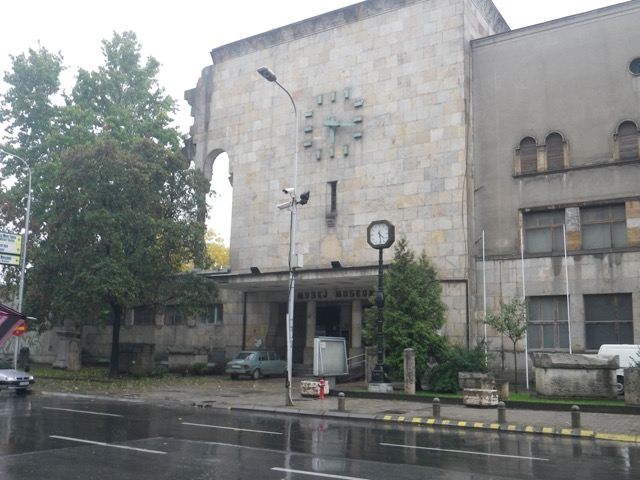
The derelict look is intentional and along with the clocks commemorates the last major earthquake in the city, dating back to 1963. Skopje has had three major earthquakes in its recorded history and it was completely demolished in each one. So there is very little that is truly “old” in Skopje and perhaps this is why it has no identity of its own. Miho calls the problem with Skopje “copy/paste syndrome” in that the city is full of things copied from other cities. I said that it reminds me of Las Vegas and Miho said that it’s 100 times worse because Vegas, where he has been, only has the Strip that is full of kitsch while the whole of Skopje looks like that!

This clock shows the time of the earthquake, just past 4:30AM.

Miho pronounced Skopje “Skopie-ya,” rhyming it with Sofia. It is Скопје in Macedonia Cyrillic, which does not have the “backward R” for the “ya” sound (я), which is the last sound in Sofia. I’ve been saying and hearing “Skope-ye.” So I suppose there are different ways of saying it.
Miho was not afraid to express his embarrassment of the city and the mismanagement of funds for the “Skopje 2014” project that saw heaps of money put into statues and monuments when the money could have had better uses. There is no rhyme or reason to where the statues have gone up. Take this bull, for example, a common symbol in front of stock exchanges all over the world. In Skopje, it is in front of a shoe store and a few blocks away from the Skopje stock exchange.

We headed back to the Memorial House of Mother Teresa and I finally noticed the front of the church. I have to say that this building is really beautiful!
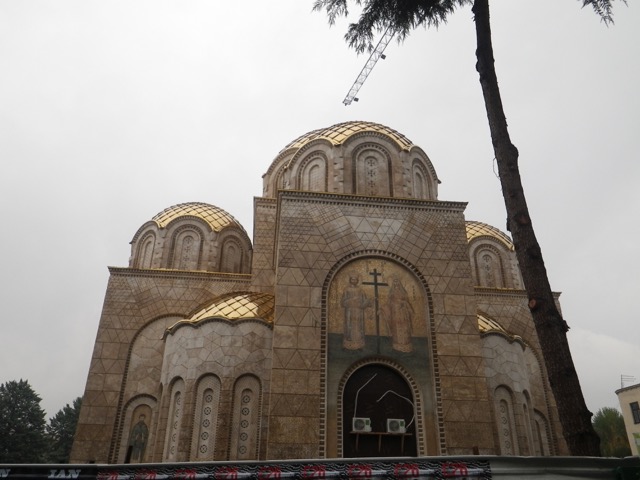
I really love the “scales” on the domes.

Miho took us through this door so we could have a laugh. I wasn’t able to get a good shot of the area, but it’s not closed in! That door does absolutely nothing.
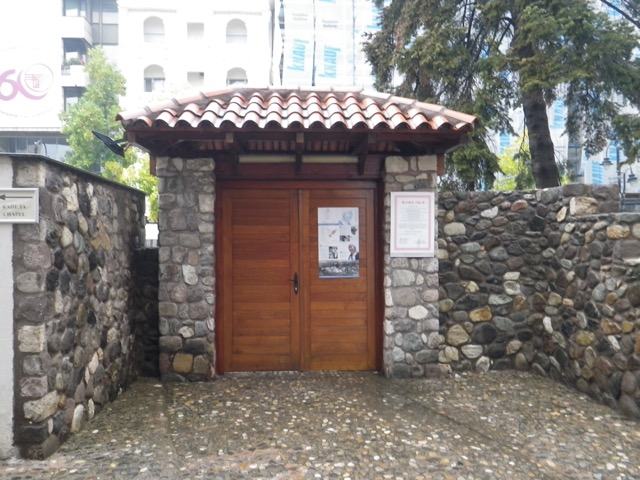
We went inside and the curator gave us some information about Mother Teresa. This is a model of what her childhood home would have looked like. There is plenty of evidence that the family was well off.

This is a letter she wrote in English, the language of her religious order.

She officially became a saint last month.

This is a copy of her Nobel Peace Prize certificate.

We went upstairs to the chapel with its unfortunately leak roof. The filigree design pays tribute to the artistry of the Ottomans and if you look closely, you can see doves and fish in the design.

We then headed towards the main square and passed two statues that make Miho angry. One is a monument to the shoeshiners of Skopje.
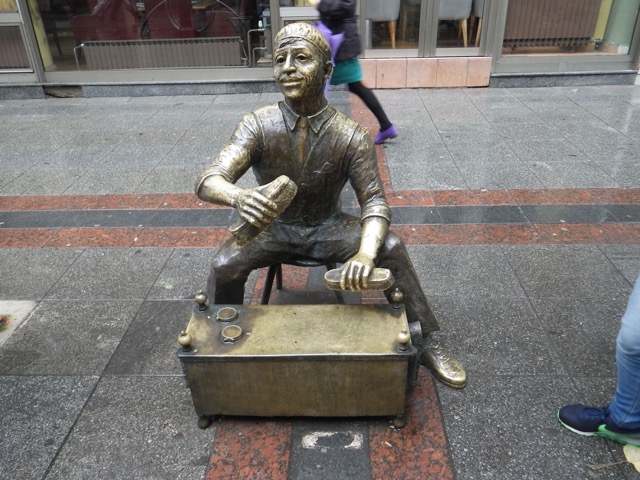
The other to beggars. Each cost something like 35,000 Euros! As he said, that money could have been put to much better use.

This is one of the few truly “old” buildings in Skopje, dating back to… 1920. It was built by a pharmacy baron and is now retail and office space.

While this is known to be a statue of Alexander the Great, the official title is Warrior on a Horse.

Just off of it, these markers show the site of where Mother Teresa’s childhood home was located. It was destroyed in the earthquake of ’63. I found these markers well done.



Here is a good example of copy/paste syndrome, just a random arch of triumph not symbolising anything in particular and in a random location.


We then got to the river. This pirate ship, too big for the river, embarrasses Miho as well. This was the first time that he actually flat out said rather than implied that he’s embarrassed by something the city has built.

This is the Museum of Archeology, one of the rare things he got really excited about, so I decided to visit it after the tour if I had time. I agree with him that the mix of neoclassical and modern architecture is stunning. This is one of the few buildings Skopje got right.


This is the Bridge of Civilisations, built in 2013. So many statues…

Skopje is running out of place for its statues, so it’s putting them on roofs and ledges. I am not being facetious.
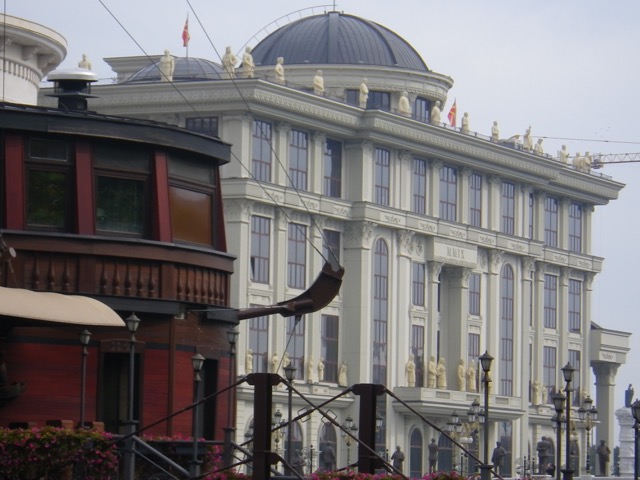
This is the Stone Bridge and actually very old, dating back to 1451. It has been added to and repaired, but is essentially original.
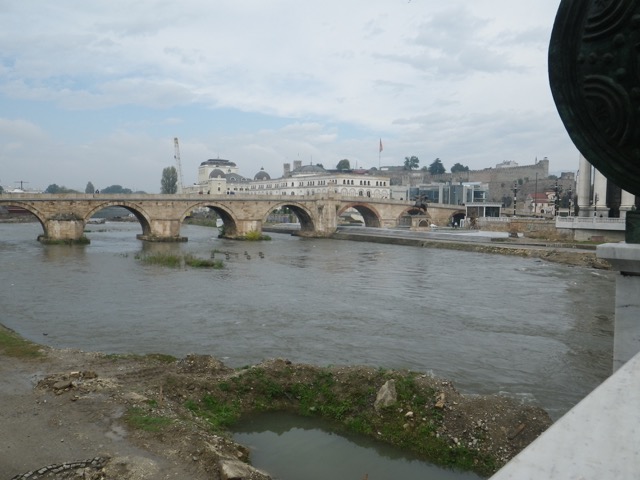

This was the only statue that spoke to me. It is of a Paeonian Priestess.
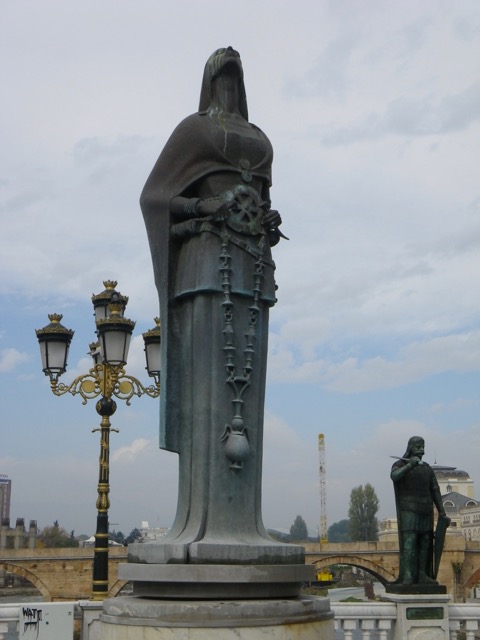
There is even a statue in the filthy river, commemorating that there was once a beach there.
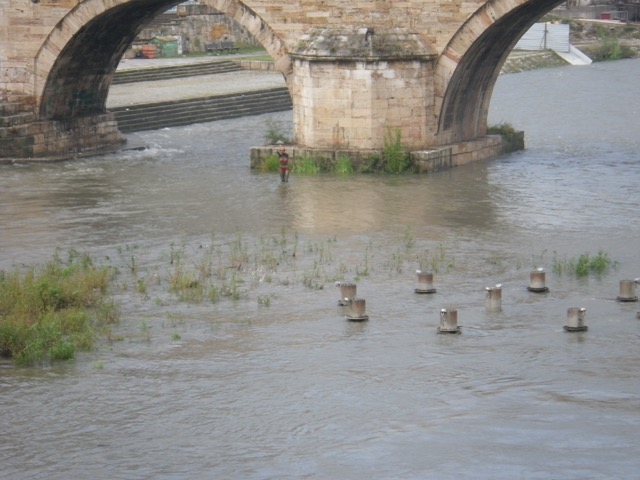
Yes, that is a woman in a red bikini. Which reminds me, all the statues in Skopje have clothes.
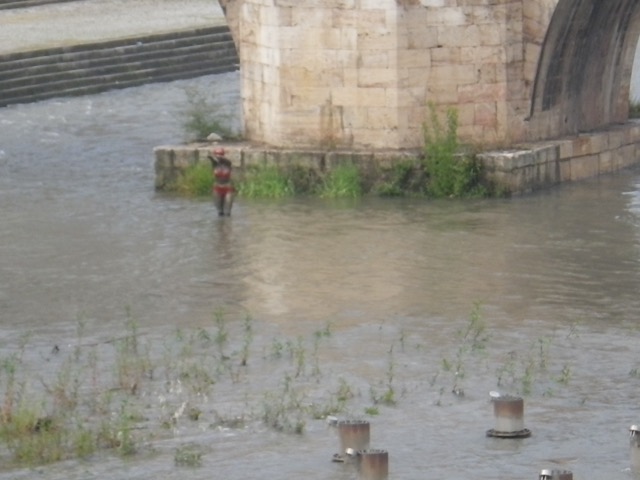
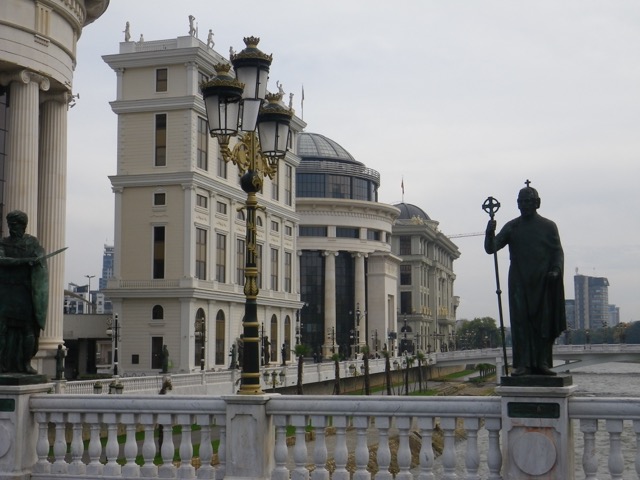
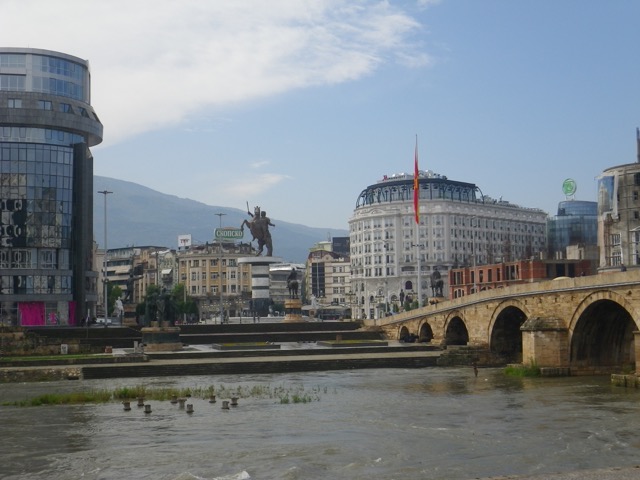
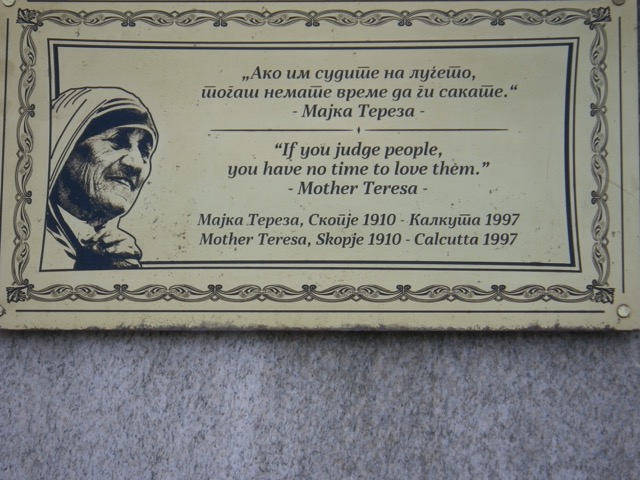
This was my least favourite stop. To keep birds from crapping on the fountains in the area and also discourage stray dogs, there is a very high pitch whistle playing constantly. I could hear it clear as a bell and it rattled the fillings in my teeth.
This is a monument to the mother of Alexander the Great, showing him while she was pregnant, he was a newborn, she was breastfeeding him, and when he was a toddler.

Behind it is another fountain, with horses. This city really has no rhyme or reason to it!
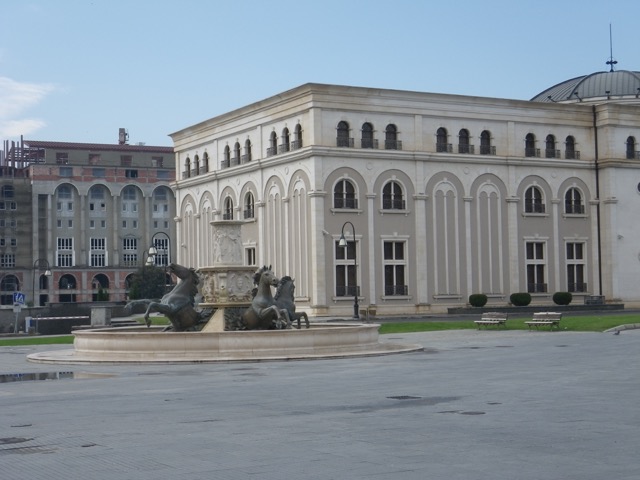
Here’s another angle on that mother of Alexander the Great fountain.
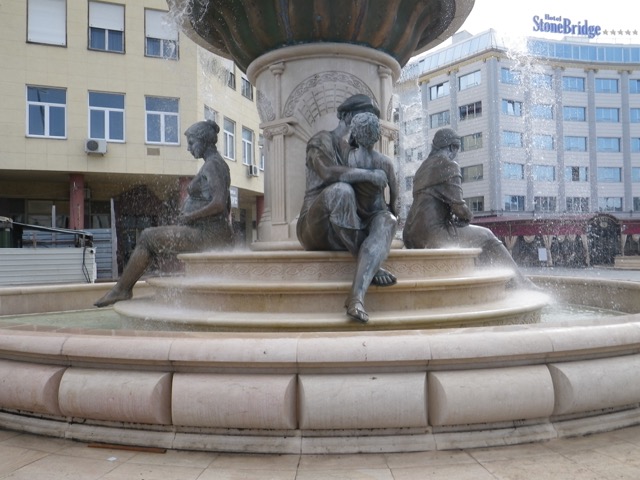
We then went into the “Old Bazaar,” which is what passes as the Old Town in Skopje. It was apparently a pretty lively place once upon a time, but now a good amount of it is deserted and what isn’t is full of shops selling tourist tchotchkes. We were advised to have lunch here as it is, surprisingly, the less expensive part of town to eat at. Which reminds me, Miho confirmed that Skopje (not sure about Macedonia in general) is about as expensive as Western Europe, which explains why I feel like I’ve been bleeding money with nothing to show for it.
The flagstones are actually old. I forget how old, but I think they date back to the Middle Ages at least.
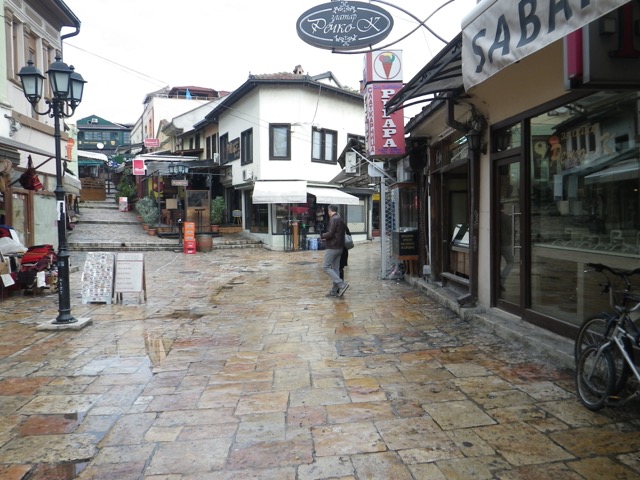
He took us to a little bar/restaurant for a rest. I had to go up and down these steps to use the bathroom. They are very common all over the Balkans and Max had them in the main house.

The other guests barely touched their complimentary glass of rakia, but I downed the whole thing. This reminded me of one I had in Bulgaria as it was very peaty and Scotch-like.

We then went into something I should have gotten the spelling of, but let’s go with “Ahn.” Think of it as an Ottoman roadhouse with lodging and food.

There would have been a fountain in the central courtyard.

This one has gone through many different lives, including being a jail, hence the bars on the windows. Now, there are a lot of lawyers offices and cafés.
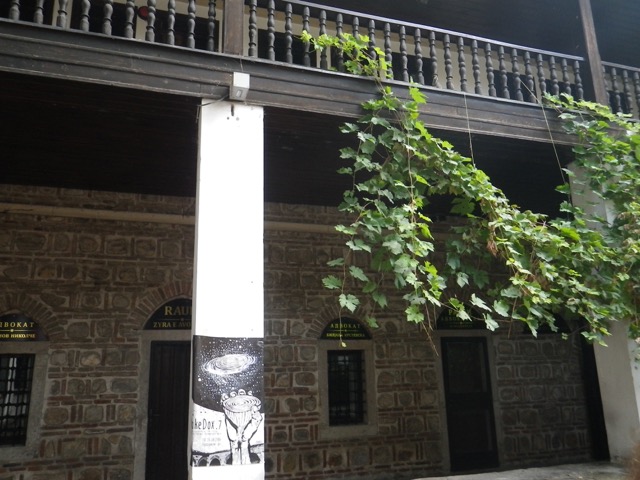

The Old Bazaar would be easy to get lost in. I am shocked that I had zero desire to wander around in it after my tour, a case of having seen much better Old Towns like these in my travels.


So much of the area was deserted, just like every other part of Skopje I’ve visited so far.
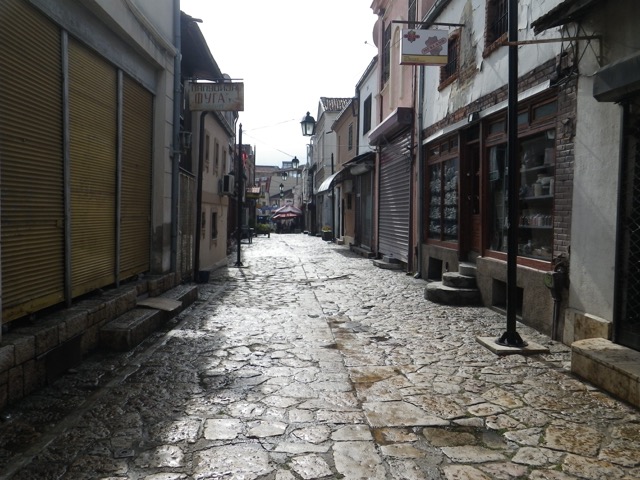
I’ve kept meaning to grab a picture of these address number plaques, white on a dark blue background. I have seen them everywhere I’ve been in the Balkans and can’t believe I forgot to ask a guide if they are issued by the government or something.

When we started the tour, Miho said we would not be able to go up to the fortress because it was storming. The fortress is the highest part of the city and he worries about lightning strikes up there when people are carrying umbrellas. But, thankfully, the rain let up fairly early on in our tour and the sky was clearing by the time we approached the fortress. So we were able to head there. First, though, he explained how there are three levels of walls to the city and that they are more symbolic, to show that people were headed into the administrative part of Skopje, than for fortification purposes.
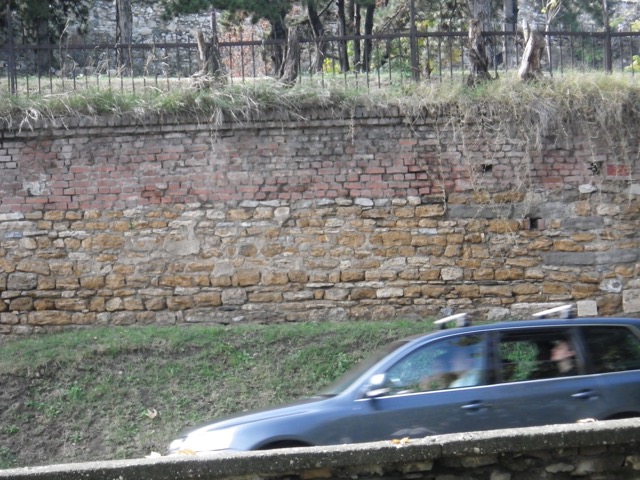






This is a football stadium.
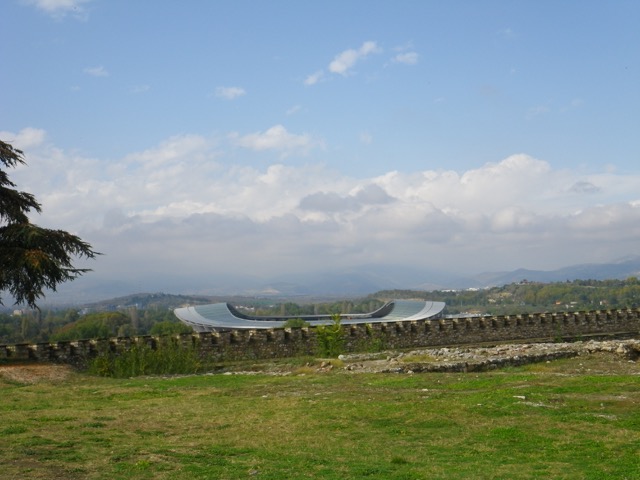
After the first recorded earthquake, Skopje was moved about 5KM from its original location, which is that hill in the distance.

There is a giant cross on top of this hill, just about twice as tall as the statue of Christ in Rio de Janeiro.
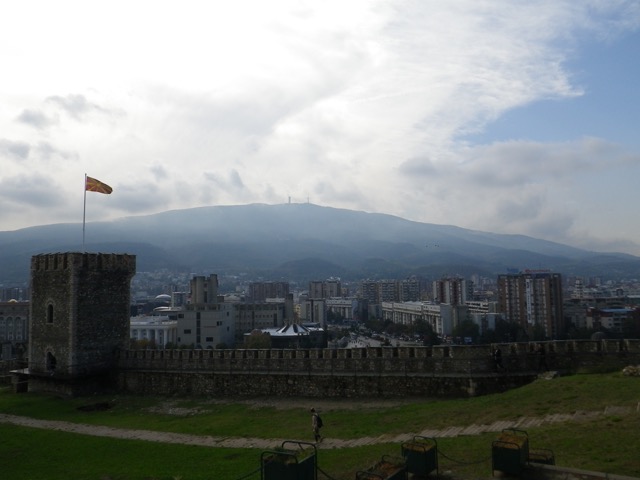

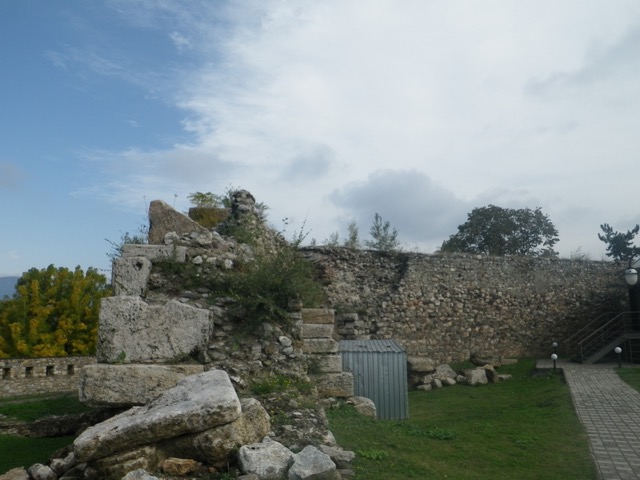
The fortress is large, but there wasn’t much to access. Having frolicked in a lot of ruins recently, I was not temped to return after the tour.
We then headed to this mosque, which was once one of the most beautiful mosques of the region.

We went inside and were told we could take photographs.
After the last earthquake, the dome was damaged and had to be rebuilt. We’ve lost the knowledge of how to build a perfect dome so, as you can see in this picture, there is an imperfect joint.
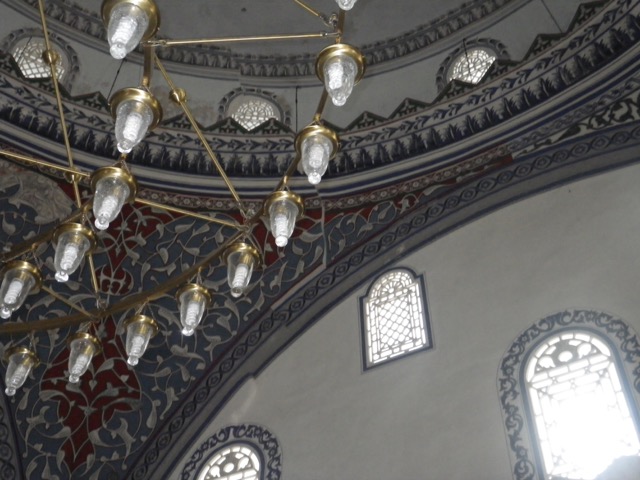
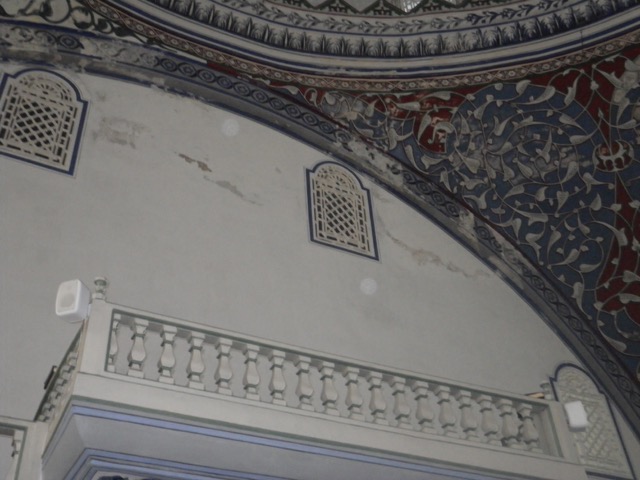





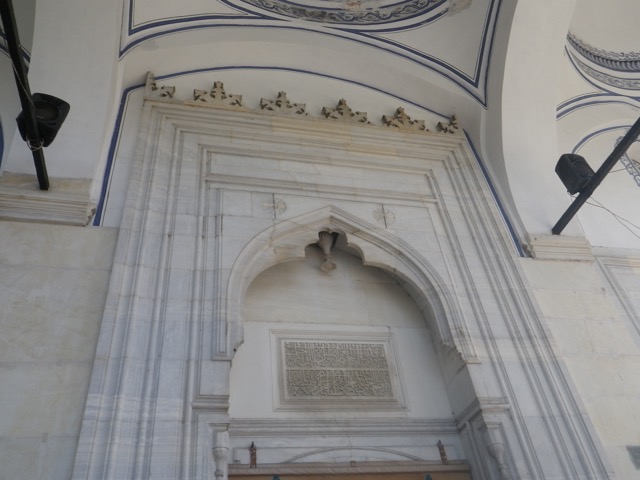
Getting in and out of our shoes was tricky as we had to step out of them on the stone part while bringing our feet onto the carpeted part.
The imam was not present when we went in and so the dress code wasn’t strict. Miho said the imam is actually pretty laid back and doesn’t make ladies cover their hair or shoulders, just their legs. Because of the weather, we were all covered from the neck to our feet anyway!

There are high tech bollards that lower for two hours a day to allow delivery vans access to the area.

This is where we finished our tour, a full hour later than expected. Miho had said the tour would take 2.5 to 3 hours and it ended up being a full 4! We finished by a church he told us to visit, but, frankly, I’ve had my fill of churches. I gave him a 300MKD tip since these “free” tours are tip based and then headed off to find an ATM so I could afford to buy lunch. I cannot believe how fast my money has gone here.
Finding an ATM took ages! The first one I tried was out of money and then I had to go back to the main square and poke around there to find one that was working. I took out another 2000MKD (50CAD) and went back to the Old Bazaar to get lunch. The first place I passed served pizza and that worked for me. I hadn’t eaten since about 8AM and had had that shot of rakia, so I really needed food and wasn’t in the mood to hunt for something else, especially when I saw that this joint had a wood fired oven.
The pizza was very good, just needing maybe one more minute in the oven to crisp up the crust, but the sauce, cheese, and sprinkle of oregano were spot on. I will miss Balkan pizza!
I had this Macedonian beer with it. The price of the pizza, 150MKD or 3.75CAD, was very reasonable for the amount I got and felt pretty close to what I paid in Serbia and Bulgaria for a comparable amount. But the beer was a whopping 3.25CAD! I would never have ordered a beer had I known it would be that expensive.
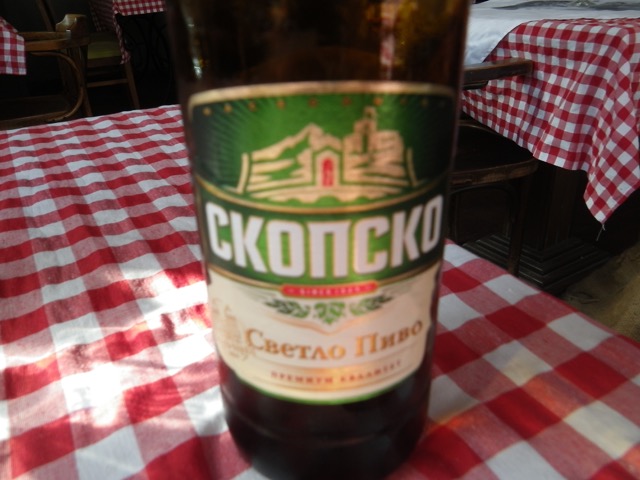
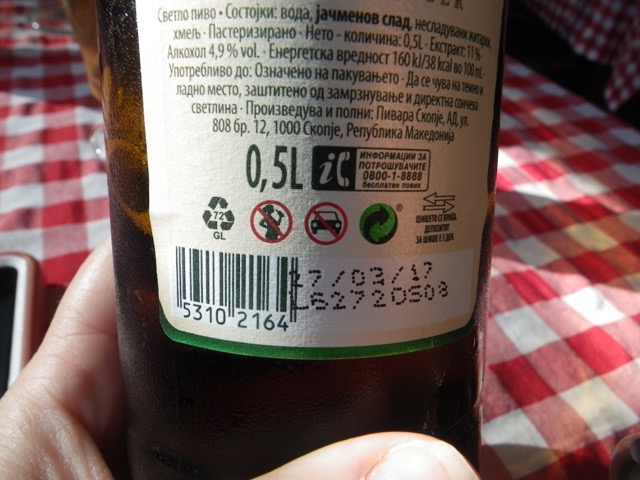
I was happier when I paid the ice cream vendor I went to next as the cost was just 0.50CAD for a small ice cream that I would have paid 1.50CAD for in Kotor. I went with straight up hazelnut and it was really yummy!
It was getting really late, so I then hoofed it to the Museum of Archeology, where you are only allowed to take pictures inside the lobby.

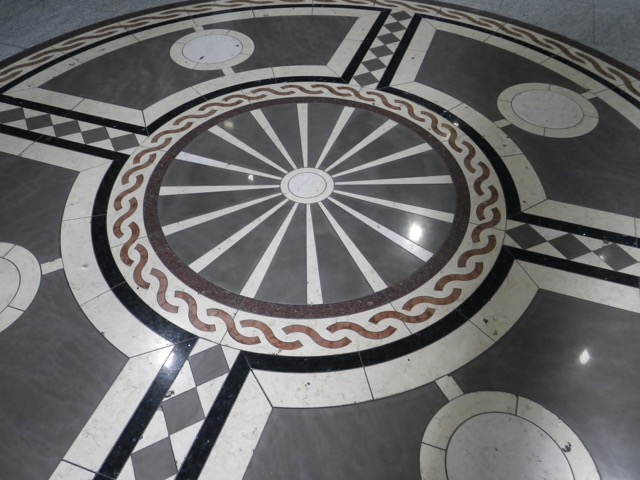
Admission to the museum was 300MKD (7.50CAD), very steep compared to other museums I’ve been to. But holy smokes! I finally found something in Skopje to wholeheartedly recommend! What an incredible collection of artifacts! As a history major, I’ve read so much about this part of the world and how people lived, but to see actual artifacts from here was surreal. The rooms were themed, with coins, jewellery, pottery, glassware, weapons, and more. There were also beautiful paintings depicting scenes of everyday life. There wasn’t quite enough signage in English though. All the artifacts had English labels, but there were large informational panels that did not have a translation, which was a bit frustrating as I could pick out just enough to get an idea of what the panel was about and be curious to know more. I kicked myself for having deleted my Bulgarian dictionary app from my phone.
Which brings me to the unpleasant part of visiting the Skopje Museum of Archeology — I got followed by security guards the whole time. The second I pulled out my phone to look for the dictionary, one rushed me and said I could not “make pictures.” The attention made it very difficult to relax and truly enjoy my visit. But all that aside, this museum is the only part of Skopje I really want to remember besides my flat!
It was starting to spit when I came out of the museum, so I took that as a sign that I should head home. I crossed the Bridge of Civilisations again.

It would make more of an impact if it wasn’t one of several bridges and was in a more central location. And wasn’t surrounded by 50 billion other statutes, monuments, and fountains.
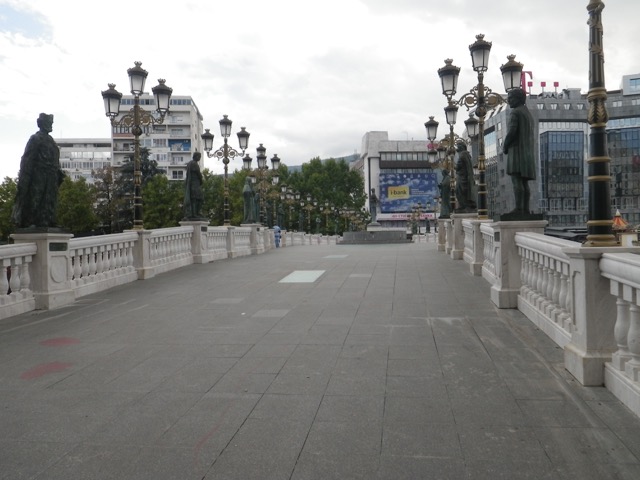
But I really do like her a lot. There was more about her in the museum, including the actual artifacts she’s holding… and her skull.
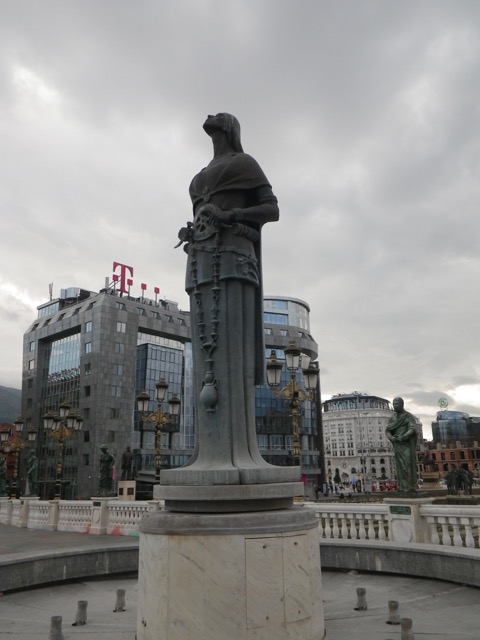
There have been a lot of “revolutions” in Skopje, with people protesting the government. The latest one had folks filling balloons with paint and then throwing the balloons at monuments built for Skopje 2014. So all that paint over the monuments isn’t artistic expression, it’s a tantrum. What a waste. Miho had stronger words to say on this subject.

Here’s that “old” building in full.

I am really glad I did the walking tour today as I got a lot of context about Skopje and Macedonia. Miho was a fantastic guide! But unlike with other walking tours I’ve done that left me itchy to explore on my own, I’d had my fill of Skopje by the end of this one. This is not a city I would recommend. There is no point to it, it’s filthy, and it’s expensive. It’s fine for a day or two if you’re flying in and out of Macedonia, but I really wish I’d had time to go to Ohrid instead.
As it turns out, I’m flying out at 6PM tomorrow, not 16:00 (4PM) and have the apartment till 2PM. I’ll have some work to do in the morning, then we’ll see if I feel like venturing out to see more of Skopje… It is surreal to think that I’ll be in Barcelona tomorrow night. I’ll be there in just about 26 hours.



